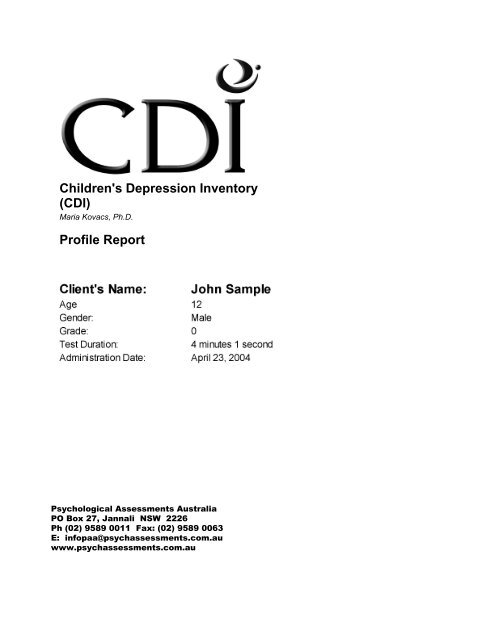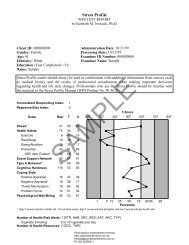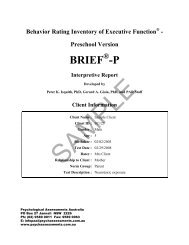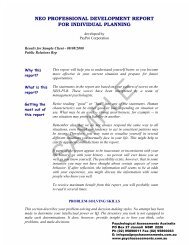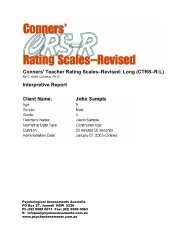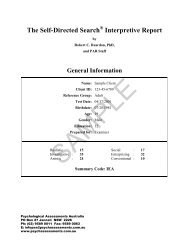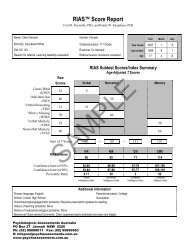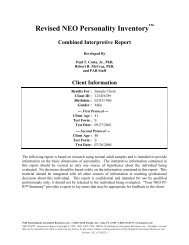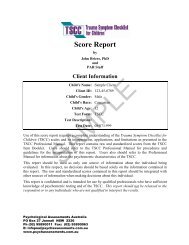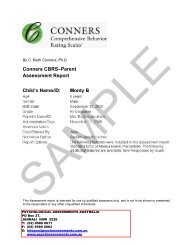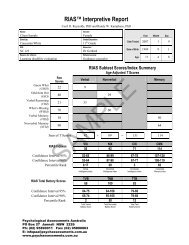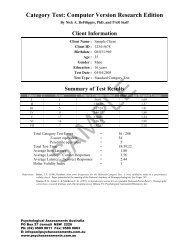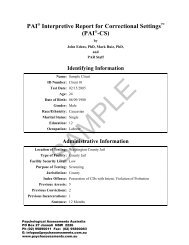Children's Depression Inventory (CDI) Profile Report - Psychological ...
Children's Depression Inventory (CDI) Profile Report - Psychological ...
Children's Depression Inventory (CDI) Profile Report - Psychological ...
You also want an ePaper? Increase the reach of your titles
YUMPU automatically turns print PDFs into web optimized ePapers that Google loves.
<strong>Children's</strong> <strong>Depression</strong> <strong>Inventory</strong><br />
(<strong>CDI</strong>)<br />
Maria Kovacs, Ph.D.<br />
<strong>Profile</strong> <strong>Report</strong><br />
This <strong>Profile</strong> <strong>Report</strong> is intended for the sole use of the test administrator and is not to be shown or<br />
presented to the respondent or to any other party.<br />
Copyright © 2004 Maria Kovacs, Ph.D. and Multi-Health Systems Inc. All rights<br />
reserved.<br />
P.O. Box 950, North Tonawanda, NY 14120-0950<br />
3770 Victoria Park Ave., Toronto, ON M2H 3M6
<strong>CDI</strong> <strong>Profile</strong> <strong>Report</strong> for John Sample Page 2<br />
Introduction<br />
The Children’s <strong>Depression</strong> <strong>Inventory</strong> (<strong>CDI</strong>) is a 27-item, self-rated, symptom-oriented scale suitable for<br />
youths aged 7 to 17. <strong>CDI</strong> T-scores are based on a normative sample of 1266 youths and are calculated<br />
based on age (7 to 12 or 13 to 17) and gender. The <strong>CDI</strong> is sensitive to changes in depressive symptoms<br />
over time and is a useful index of the severity of the depressive syndrome. This report provides<br />
information about the youth’s scores and how they compare with the scores of the normative sample of<br />
non-clinical individuals. See the <strong>CDI</strong> Technical Manual (published by MHS) for more information about<br />
this instrument and its results.<br />
Cautionary Remarks<br />
This computerized report is meant to act as an interpretive aid and should not be used as the sole basis<br />
for intervention or clinical diagnosis. This report works best when combined with other sources of<br />
relevant information (e.g., tests, observations, historical information). The report is based on an<br />
algorithm that produces the most common interpretations for the scores that have been obtained.<br />
Atypical interpretations must be explored in other ways on a case-by-case basis. The information<br />
contained in this report should be treated as confidential.<br />
<strong>CDI</strong> T-Scores<br />
The following graph provides John’s T-scores for each of the <strong>CDI</strong> scales.
<strong>CDI</strong> <strong>Profile</strong> <strong>Report</strong> for John Sample Page 3<br />
Summary of Scale Scores<br />
The following table summarizes John’s scale scores and gives general information about how he<br />
compares to the normative group. More interpretive data are provided later in this report.<br />
Validity of the <strong>Report</strong><br />
A validity check indicated that this individual answered the items in a generally consistent manner.<br />
These responses should be considered valid.<br />
<strong>Profile</strong> Summary<br />
The pattern of responses given for the <strong>CDI</strong> indicate that John has no evident depressive symptoms.<br />
John's response to Question #9 indicates that John frequently thinks about killing himself/herself. This<br />
response must be verified and examined immediately in a face-to-face interview by an individual skilled<br />
in clinical evaluation.<br />
Elevated Scales<br />
There are no significantly elevated scales.<br />
Examination of Scale Scores<br />
<strong>CDI</strong> T-scores of 65 or above identify potentially clinically depressed individuals. Lower cut-off values<br />
may be more appropriate for situations where an atypically high incidence of depression is expected.<br />
The T-score = 65 cutoff should be used as a guideline and not an absolute rule.<br />
Total Score: T-score=50<br />
John’s <strong>CDI</strong> Total Score is in the low range, suggesting no evident difficulties.<br />
Negative Mood: T-score=44<br />
This scale reflects feeling sad, feeling like crying, worrying about “bad things”, being bothered or upset<br />
by things, and being unable to make up one’s mind.<br />
John's score on the Negative Mood scale is in the low range, suggesting no evident difficulties.<br />
Interpersonal Problems: T-score=49<br />
This scale reflects problems and difficulties in interactions with people, including trouble getting along<br />
with people, social avoidance, and social isolation.<br />
John's score on the Interpersonal Problems scale is in the low range, suggesting no evident difficulties.
<strong>CDI</strong> <strong>Profile</strong> <strong>Report</strong> for John Sample Page 4<br />
Ineffectiveness: T-score=59<br />
This scale reflects a negative evaluation of one’s ability and school performance.<br />
John's score on the Ineffectiveness scale is in the low range, suggesting no evident difficulties.<br />
Anhedonia: T-score=48<br />
This scale reflects impaired ability to experience pleasure. Individuals scoring high on this scale may<br />
suffer from loss of energy and problems with sleeping and appetite.<br />
John's score on the Anhedonia scale is in the low range, suggesting no evident difficulties.<br />
Negative Self-Esteem: T-score=51<br />
This scale reflects low self-esteem, self-dislike, and feelings of being unloved.<br />
John's score on the Negative Self-Esteem scale is in the low range, suggesting no evident difficulties.<br />
Item Response Table<br />
John made the following response choices.<br />
Integrating Results and Considering Intervention<br />
<strong>CDI</strong> results must be incorporated with other information before drawing any conclusions. It is<br />
recommended that a comprehensive evaluation include direct clinical observation of the youth,<br />
information from other relevant assessments, and information about the youth’s background, family<br />
history, and school adjustment.<br />
Date Printed: Friday, April 23, 2004<br />
End of <strong>Report</strong>


